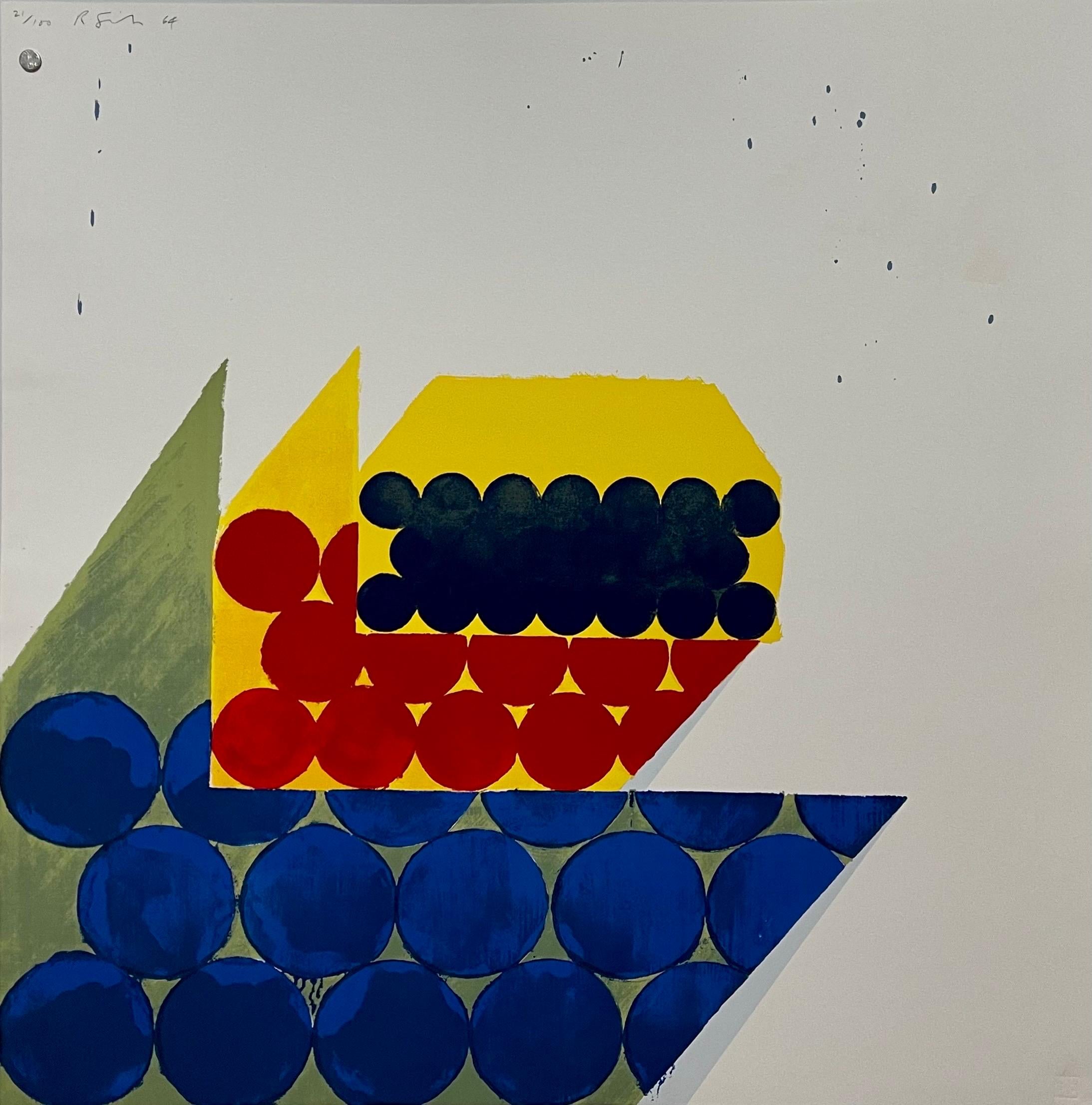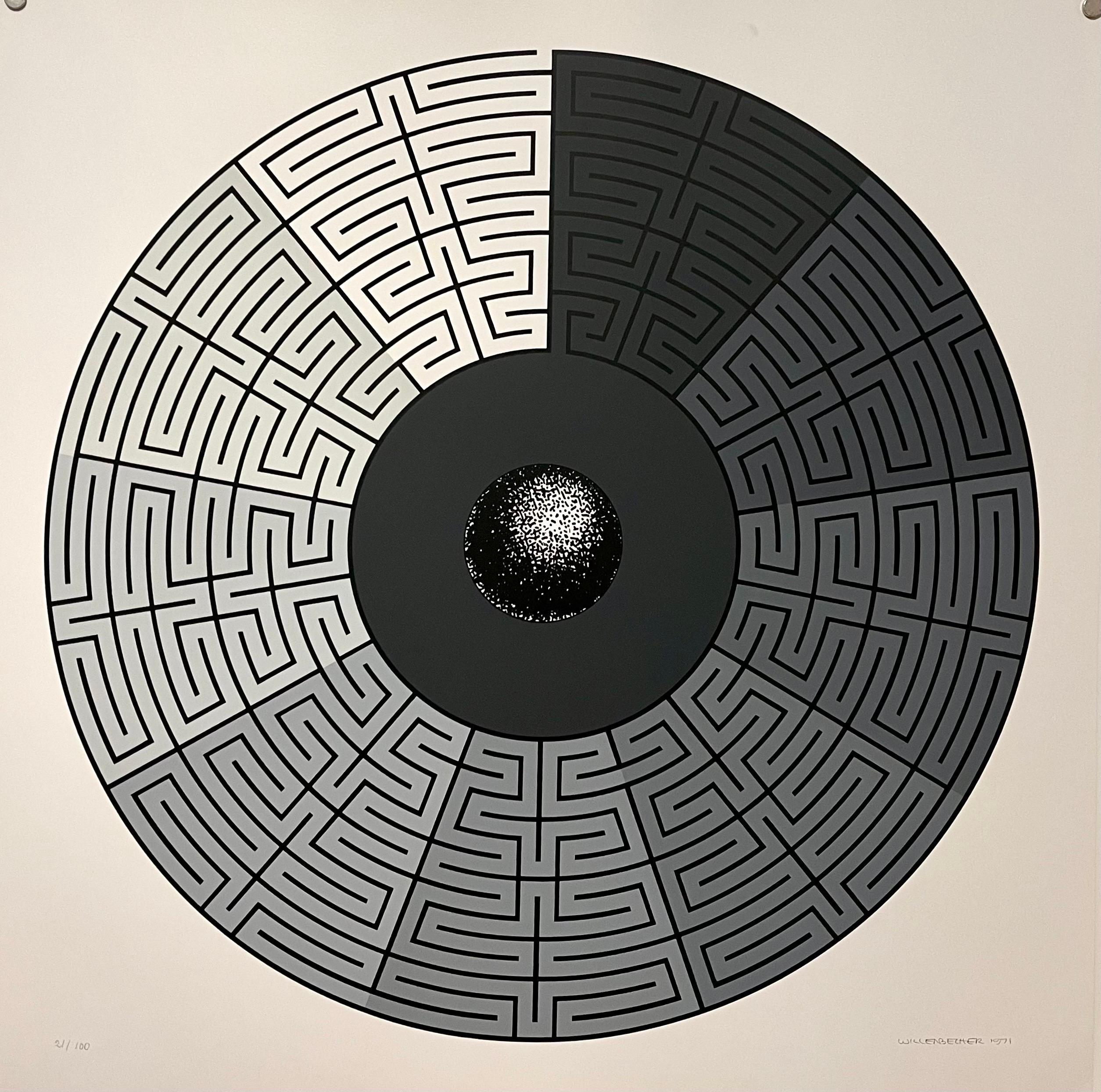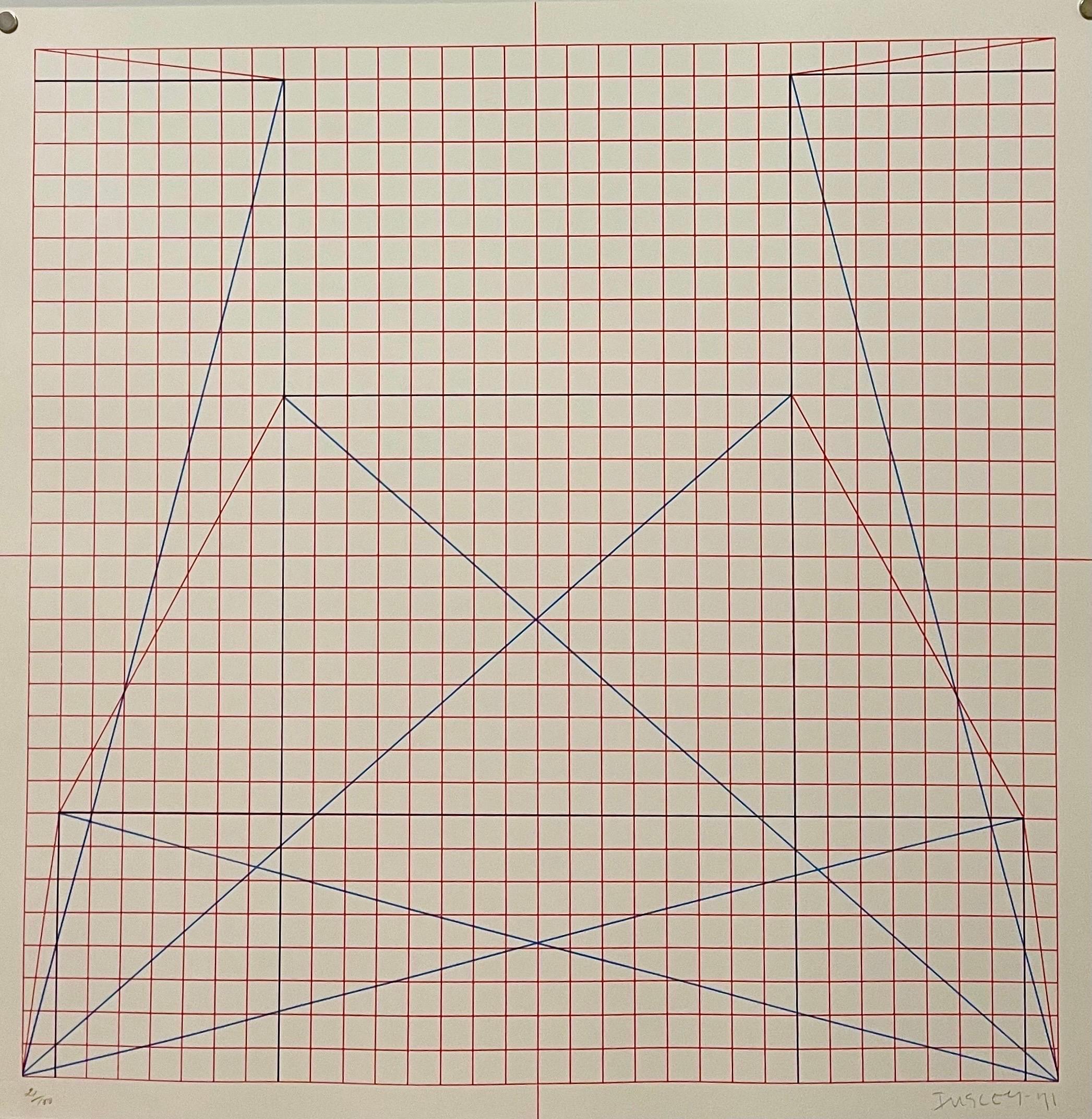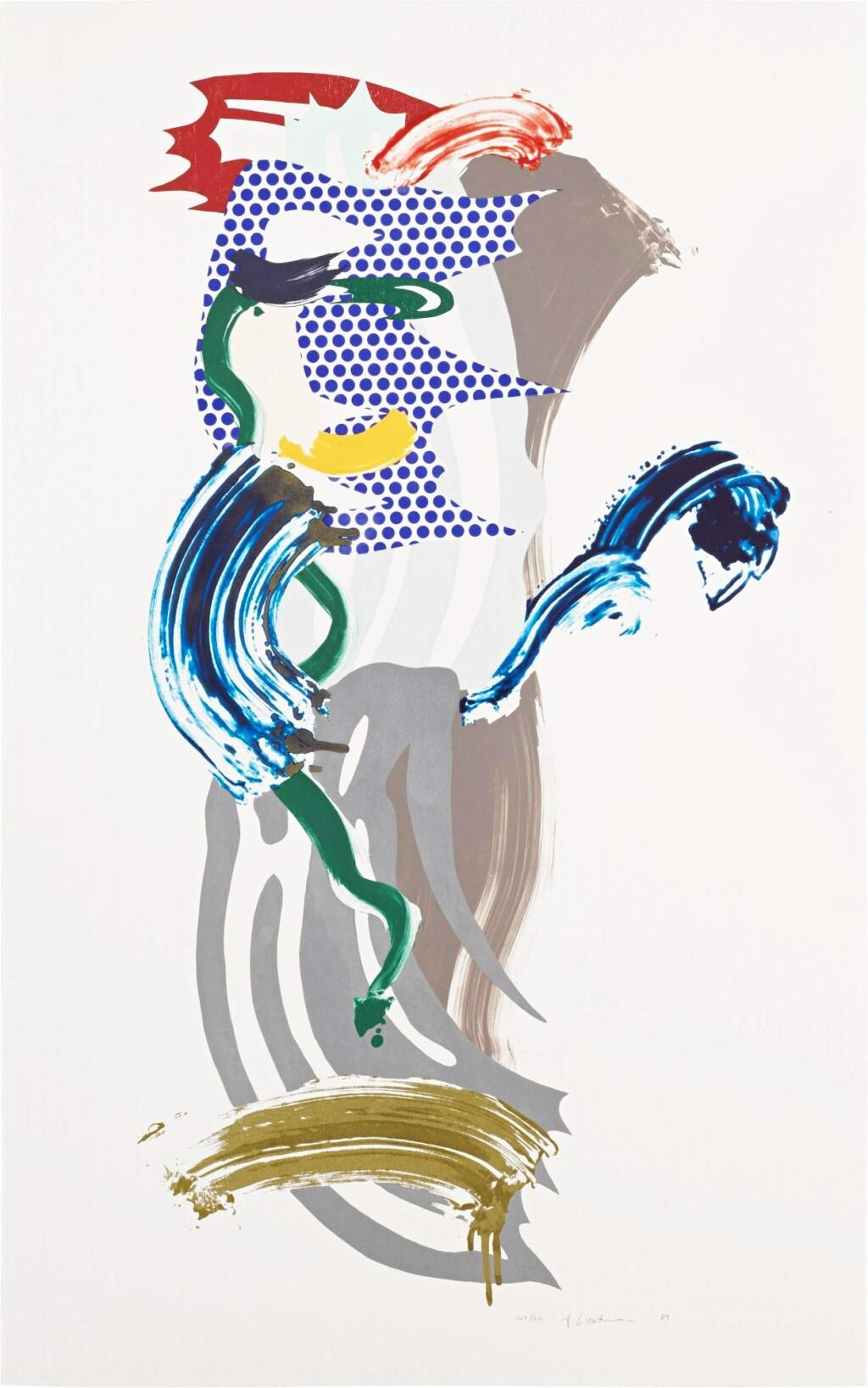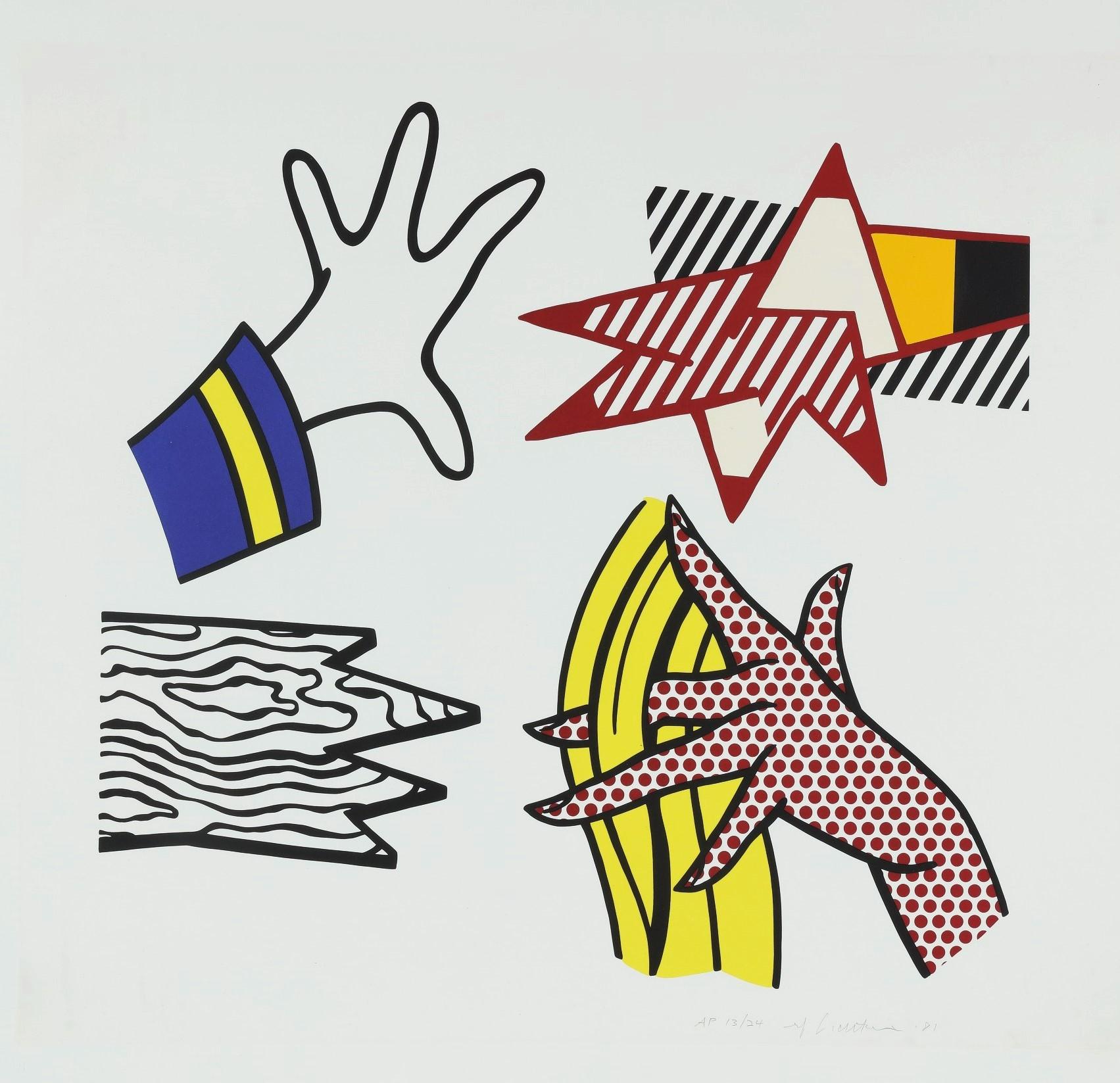Items Similar to 1969-71 Abstract Minimalist Color Silkscreen Print Charles Hinman On The Bowery
Want more images or videos?
Request additional images or videos from the seller
1 of 10
Charles Hinman1969-71 Abstract Minimalist Color Silkscreen Print Charles Hinman On The Bowery 1969-1971
1969-1971
About the Item
Charles Hinman
On the Bowery, 1969 - 1971
silkscreen on Schoeller's Parole Paper, edition of 100 + 20 A.P.
25.5 x 25.5 inches, signed, numbered 21/100
Screenprint in color on wove paper
Hand signed, published by Edition Domberger, Bonlanden, West Germany (with their blindstamp)
Provenance: Collection of Tom Levine
On the Bowery, 1971. The portfolio consists of nine screenprints in colors (one with mylar collage), on wove paper, by representative artists of the Pop Art period. Cy Twombly, Robert Ryman, Will Insley, Robert Indiana, Les Levine, John Willenbecher, Charles Hinman, Richard Smith, Gerald Laing, and John Giorno. The ten artists were photographed by Eliot Elisofon (1911-1973), who also lived on the Bowery and was a founding member of the Photo League in 1936.
In the late 40s and 50s Clyfford Still, Mark Rothko, Fernand Leger and Jean Dubuffet, among others, had studios on the Bowery, and Willem de Kooning, Franz Kline and Reginald Marsh worked nearby. In the early 60s, Louise Nevelson took a place on Mott Street just off the Bowery and was joined not long after by other artists attracted by the lofts for reasonable rents and the relaxed, small-time quality of the area. - William Katz, from the introduction for the portfolio.
Among other artists, writers and photographers who have lived or worked there are: Arman, Jack Brusca, Larry Calcagno, Pierre Clerk, Tom Doyle, Jean Dupuy, Janet Fish, Robert Frank, Adolph Gottlieb, Eva Hesse, Roy Lichtenstein, Jay Maisel, Ed Meneeley, Malcolm Morley, Kenneth Noland, Angelo Savelli, and Tom Wesselmann.
Charles Hinman born 1932 in Syracuse, New York is an Abstract Minimalist painter, notable for creating three-dimensional shaped canvas paintings in the mid-1960s. Hinman initiated his artistic education at the Syracuse Museum of Fine Arts, now the Everson Museum of Art, where he attended classes. He went on to complete his BFA in 1955 at Syracuse University. Alongside his artistic talent, Charles Hinman was also dedicated to sports. While studying at university he was a professional baseball player for the Milwaukee Braves in the minor league. He moved to New York to study at the Arts Student League before serving two years in the army. In the early 1960s Hinman lived on Coenties Slip in Lower Manhattan where he shared an abandoned sail-making loft with James Rosenquist. It was an ideal art studio offering large open spaces to work at an affordable rent. Along with Robert Indiana, Ellsworth Kelly, Jack Youngerman and Agnes Martin who resided in the neighbouring buildings, they formed a small artistic community away from the Upper-East side and the Abstract Expressionists from whom they wished to differentiate themselves.Throughout the 1960s they produced works that prefigured Pop, Minimal and Feminist Art.
Two exhibitions in 1964-65 introduced Hinman's work to the grand public and to critical attention; "Seven New Artists" at the Sidney Janis Gallery and a solo exhibition at the Richard Feigen Gallery. In 1965 Frank Stella and Henry Geldzahler included Hinman's work in their group show "Shape and Structure" at Tibor de Nagy, alongside Donald Judd, Larry Bell, Sol LeWitt, Carl Andre and Will Insley. His work was shown at the Whitney Museum's landmark show "Young America 1965" and the following year in "United States 1670-1966". Hinman was represented by Richard Feigen who showed his work at his New York and Chicago galleries. While major museums such as the MOMA, the Whitney Museum and the Albright–Knox Art Gallery soon bought his work for their permanent collections, his paintings also found a home in the collection of Nelson Rockefeller. From 1971 to 1973 the Parisian gallerist Denise René showed his work at her Paris and New York galleries. In 2014, Charles Hinman was included in the group show "Shaped Canvas Revisited" at the Luxembourg and Dayan Gallery in New York. This exhibition, which celebrated the fifty years of the original Guggenheim show, places Hinman among the fathers of the shaped canvas movement alongside artists such as Lucio Fontana, Kenneth Noland, Frank Stella and Tom Wesselmann.
Selected group shows
2014 Shaped Canvas Revisited, Luxembourg and Dayan, New York, NY, USA
2004 Blast from the Past, Pace Editions, New York, NY, USA
1989 American Painting Since the Death of Painting, curated by Donald Kuspit, Kuznetsky Most Moscow, USSR
1967 Whitney Annual Exhibition, Whitney Museum, New York, NY, USA
1965 Recent Acquisitions, MOMA (Museum of Modern Art), New York, NY, USA
1965 Shape and Structure, Tibor de Nagy Gallery, New York, NY, USA
Selected museum collections
Museum of Modern Art, New York, NY, USA
Whitney Museum of American Art, New York, NY, USA
Los Angeles County Museum, Los Angeles, CA, USA
Hirshhorn Museum, Washington, DC, USA
Musee' des Beaux Arts de l'Ontario, Toronto, Ontario, Canada
Tel Aviv Museum, Tel Aviv, Israel
Albright Knox Art Gallery, Buffalo, NY, USA
- Creator:Charles Hinman (1932, American)
- Creation Year:1969-1971
- Dimensions:Height: 25.5 in (64.77 cm)Width: 25.5 in (64.77 cm)
- Medium:
- Movement & Style:
- Period:
- Condition:good. minor wear. never framed. kept in original portfolio.
- Gallery Location:Surfside, FL
- Reference Number:1stDibs: LU38210285742
About the Seller
4.9
Platinum Seller
These expertly vetted sellers are 1stDibs' most experienced sellers and are rated highest by our customers.
Established in 1995
1stDibs seller since 2014
1,568 sales on 1stDibs
Typical response time: 1 hour
- ShippingRetrieving quote...Ships From: Surfside, FL
- Return PolicyA return for this item may be initiated within 3 days of delivery.
More From This SellerView All
- Abstract Minimalist Color Silkscreen Print Richard Smith On The Bowery Pop ArtBy Richard SmithLocated in Surfside, FLRichard Smith On the Bowery, 1969 - 1971 silkscreen on Schoeller's Parole Paper, edition of 100 + 20 A.P. 25.5 x 25.5 inches, signed, numbered 21/100 Screenprint in color on wove paper Hand signed, published by Edition Domberger, Bonlanden, West Germany (with their blindstamp) Provenance: Collection of Tom Levine On the Bowery, 1971. The portfolio consists of nine screenprints in colors (one with mylar collage), on wove paper, by representative artists of the Pop Art period. Cy Twombly, Robert Ryman, Will Insley, Robert Indiana, Les Levine, John Willenbecher...Category
1960s Pop Art Abstract Prints
MaterialsLithograph, Screen
- Abstract Minimalist Color Silkscreen Print John Willenbecher The Bowery Pop ArtLocated in Surfside, FLJohn Willenbecher On the Bowery, 1969 - 1971 silkscreen on Schoeller's Parole Paper, edition of 100 + 20 A.P. 25.5 x 25.5 inches, signed, numbered 2...Category
1960s Pop Art Abstract Prints
MaterialsLithograph, Screen
- Abstract Minimalist Color Silkscreen Print Will Insley On The Bowery Pop ArtLocated in Surfside, FLWill Insley On the Bowery, 1969 - 1971 silkscreen on Schoeller's Parole Paper, edition of 100 + 20 A.P. 25.5 x 25.5 inches, signed, numbered 21/100 Screenprint in color on wove paper Hand signed, published by Edition Domberger, Bonlanden, West Germany (with their blindstamp) Provenance: Collection of Tom Levine On the Bowery, 1971. The portfolio consists of nine screenprints in colors (one with mylar collage), on wove paper, by representative artists of the Pop Art period. Cy Twombly, Robert Ryman, Will Insley, Robert Indiana, Les Levine, John Willenbecher...Category
1960s Pop Art Abstract Prints
MaterialsLithograph, Screen
- Color Silkscreen Pop Art Lithograph Print Les Levine Canadian Pop Art PortraitBy Les LevineLocated in Surfside, FLLes Levine On the Bowery, 1969 - 1971 Screenprint in color 25.5 x 25.5 inches, signed, numbered 21/100 Hand signed, published by Edition Domberger, Bonlanden, West Germany (with their blindstamp) Provenance: Collection of Tom Levine On the Bowery, 1971. The portfolio consists of nine screenprints in colors (one with mylar collage), on wove paper, by representative artists of the Pop Art period. Cy Twombly, Robert Ryman, Will Insley, Robert Indiana, Les Levine, John Willenbecher...Category
1960s Pop Art Abstract Prints
MaterialsLithograph, Screen
- Judy Rifka Abstract Expressionist Contemporary Lithograph Hebrew 10 CommandmentBy Judy RifkaLocated in Surfside, FLJudy Rifka (American, b. 1945) 44/84 Lithograph on paper titled "Thou Shalt Not Bear False Witness against Thy Neighbor"; Depicting an abstract composition in blue, green, red and black tones with Hebrew script. Judaica interest. (I have seen this print described as a screenprint and as a lithograph) Hand signed in pencil and dated alongside an embossed pictorial blindstamp of a closed hand with one raised index finger. Solo Press. From The Ten Commandments Kenny Scharf; Joseph Nechvatal; Gretchen Bender; April Gornik; Robert Kushner; Nancy Spero; Vito Acconci; Jane Dickson; Judy Rifka; Richard Bosman and Lisa Liebmann. Judy Rifka (born 1945) is an American woman artist active since the 1970s as a painter and video artist. She works heavily in New York City's Tribeca and Lower East Side and has associated with movements coming out of the area in the 1970s and 1980s such as Colab and the East Village, Manhattan art scene. A video artist, book artist and abstract painter, Rifka is a multi-faceted artist who has worked in a variety of media in addition to her painting and printmaking. She was born in 1945 in New York City and studied art at Hunter College, the New York Studio School and the Skowhegan School of Painting and Sculpture in Maine. Rifka took part in the 1980 Times Square Show, (Organized by Collaborative Projects, Inc. in 1980 at what was once a massage parlor, with now-famous participants such as Jenny Holzer, Nan Goldin, Keith Haring, Kenny Scharf, Jean-Michel Basquiat, and Kiki Smith, the roster of the exhibition reads like a who’s who of the art world), two Whitney Museum Biennials (1975, 1983), Documenta 7, Just Another Asshole (1981), curated by Carlo McCormick and received the cover of Art in America in 1984 for her series, "Architecture," which employed the three-dimensional stretchers that she adopted in exhibitions dating to 1982; in a 1985 review in the New York Times, Vivien Raynor noted Rifka's shift to large paintings of the female nude, which also employed the three-dimensional stretchers. In a 1985 episode of Miami Vice, Bianca Jagger played a character attacked in front of Rifka's three-dimensional nude still-life, "Bacchanaal", which was on display at the Museum of Art Fort Lauderdale. Rene Ricard wrote about Rifka in his influential December 1987 Art Forum article about the iconic identity of artists from Van Gogh to Jean-Michel Basquiat and Keith Haring, The Radiant Child.The untitled acrylic painting on plywood, in the collection of the Honolulu Museum of Art, demonstrates the artist's use of plywood as a substrate for painting. Artist and writer Mark Bloch called her work "imaginative surfaces that support experimental laboratories for interferences in sensuous pigment." According to artist and curator Greg de la Haba, Judy Rifka's irregular polygons on plywood "are among the most important paintings of the decade". In 2013, Rifka's daily posts on Facebook garnered a large social media audience for her imaginative "selfies," erudite friendly comments, and widely attended solo and group exhibitions, Judy Rifka's pop art figuration is noted for its nervous line and frenetic pace. In the January 1998 issue of Art in America, Vincent Carducci echoed Masheck, “Rifka reworks the neo-classical and the pop, setting all sources in quotation for today’s art-world cognoscenti.” Rifka, along with artists like David Wojnarowicz, helped to take Pop sensibility into a milieu that incorporated politics and high art into Postmodernism; Robert Pincus-Witten stated in his 1988 essay, Corinthian Crackerjacks & Passing Go that "Rifka’s commitment to process and discovery, doctrine with Abstract Expressionist practice, is of paramount concern though there is nothing dogmatic or pious about Rifka’s use of method. Playful rapidity and delight in discovery is everywhere evident in her painting." In 2016, a large retrospective of Rifka's art was shown at the Jean-Paul Najar Foundation in Dubai. In 2017, Gregory de la Haba presented a Rifka retrospective at the Amstel Gallery in The Yard, a section of Manhattan described as "a labyrinth of small cubicles, conference rooms and small office spaces that are rented out to young entrepreneurs, professionals and hipsters". In 2019 her video Bubble Dancers New Space Ritual was selected for the International Istanbul Bienali. Alexandra Goldman Talks To Judy Rifka About Ionic Ironic: Mythos from the '80s at CORE:Club and the Inexistence of "Feminist Art" Whitehot Magazine of Contemporary Art. She was included in "50 Contemporary Women Artists", a book comprising a refined selection of current and impactful artists. The foreword is by Elizabeth Sackler of the Brooklyn Museum’s Sackler Center for Feminist Art. Additional names in the book include sculptor and carver Barbara Segal...Category
1980s Pop Art Abstract Prints
MaterialsLithograph, Screen
- Pop Art Aspen Road Sign D'arcangelo Silkscreen Chiron Press Vintage Art PosterLocated in Surfside, FLAllan D'Arcangelo (American/New York, 1930-1998), "Aspen Center of Contemporary Art", 1967 silkscreen, hand signed in pencil, dated, numbered "45/200" and blind stamped "Chiron Press, New York, NY" 32 in. x 24 in. Allan D'Arcangelo (1930-1998) was an American artist and printmaker, best known for his paintings of highways and road signs that border on pop art and minimalism, precisionism, Abstract illusionism and hard-edge painting, and also surrealism. His subject matter is distinctly American and evokes, at times, a cautious outlook on the future of this country. Allan D'Arcangelo was the son of Italian immigrants. He studied at the University of Buffalo from 1948–1953, where he got his bachelor's degree in history. After college, he moved to Manhattan and picked up his studies again at the New School of Social Research and the City University of New York, City College. At this time, he encountered Abstract Expressionist painters who were in vogue at the moment. After joining the army in the mid 1950s, he used the GI Bill to study painting at Mexico City College from 1957–59, driving there over 12 days in an old bakery truck retrofitted as a camper. However, he returned to New York in 1959, in search of the unique American experience. It was at this time that his painting took on a cool sensibility reminiscent of Roy Lichtenstein and Andy Warhol. His interests engaged with the environment, anti-Vietnam War protests, and the commodification and objectification of female sexuality. D'Arcangelo first achieved recognition in 1962, when he was invited to contribute an etching to The International Anthology of Contemporary Engraving: America Discovered; his first solo exhibition came the next year, at the Thiebaud Gallery in New York City. In 1965 he contributed three screenprints to Original Edition's 11 Pop Artists portfolio. By the 1970s, D'Arcangelo had received significant recognition in the art world. He was well known for his paintings of quintessentially American highways and infrastructure, and in 1971 was commissioned by the Department of the Interior to paint the Grand Coulee Dam in Washington state. However, his sense of morality always trumped his interest in art world fame. In 1975, he decided to quit the gallery that had been representing him for years, Marlborough Gallery, because of the way they handled Mark Rothko legacy. D'Arcangelo rejected Abstract Expressionism, though his early work has a painterly and somewhat expressive feel. He quickly turned to a style of art that seemed to border on Pop Art and Minimalism, Precisionism and Hard-Edge painting. Evidently, he didn't fit neatly in the category of Pop Art, though he shared subjects (women, signs, Superman) and techniques (stencil, assemblage) with these artists.He turned to expansive, if detached scenes of the American highway. These paintings are reminiscent of Giorgio de Chirico-though perhaps not as interested in isolation-and Salvador Dali-though there is a stronger interest in the present and disinterest in the past. These paintings also have a sharp quality that is reminiscent of the precisionist style, or more specifically, Charles Sheeler. 1950s, Before D'Arcangelo returned to New York, his style was roughly figurative and reminiscent of folk art. During the early 1960s, Allan D'Arcangelo was linked with Pop Art. "Marilyn" (1962) depicts an illustrative head and shoulders on which the facial features are marked by lettered slits to be "fitted" with the eyebrows, eyes, nose and mouth which appear off to the right in the composition. In "Madonna and Child," (1963) the featureless faces of Jackie Kennedy and Caroline are ringed with haloes, enough to make their status as contemporary icons perfectly clear. Select Exhibitions: Fischbach Gallery, New York, Ileana Sonnabend Gallery, Paris, Gallery Müller, Stuttgart, Germany Hans Neuendorf Gallery, Hamburg, Germany Dwan Gallery...Category
1960s Pop Art Abstract Prints
MaterialsLithograph, Screen
You May Also Like
- Blue FaceBy Roy LichtensteinLocated in New York, NYA stunning example of abstracted imagery easily identifiable as the work of Roy Lichtenstein, Blue Face was created by the artist in 1989 as a truly mixed me...Category
20th Century Pop Art Abstract Prints
MaterialsLithograph, Screen, Woodcut
- Study of HandsBy Roy LichtensteinLocated in New York, NYCreated in 1981 as an original lithograph with screen-printing, Roy Lichtenstein’s, Study of Hands is hand-signed in pencil, dated and numbered, measuring 31 ¼ x 32 ¾ in. (79.5 x 83....Category
20th Century Pop Art Figurative Prints
MaterialsLithograph, Screen
- Shepard Fairey Screen-prints: collection of 60 works (2009-2022)By Shepard FaireyLocated in NEW YORK, NYShepard Fairey Screen-prints: collection of 60 works: 2009-2022: A rare assemblage of 60 hand-signed Shepard Fairey screen-prints; collected over a near 15 year period (2009-2022). Notable imagery includes: Bob Marley, Keith Haring, Ruth Bader Ginsburg, Kurt Cobain, as well as a series of vivid anti-war pieces defining the artist's practice (title list found further below). Each very well-preserved. Medium: Screen-prints on heavy paper. 2009-2022 (see below for a list of titles & years). Dimensions ranging from: 19.5 x 16 inches to 24x36 inches. Each work is hand-signed; works are either numbered from their respective main editions or notated 'AP' (see last listing image); a few or several works are signed, but not numbered. Excellent overall condition with the exception of perhaps some minor signs of handling on a few examples. Provenance: Private collection New York via Shepard Fairey. Listing images beginning with image 2 represent the actual works. These works will be shipped flat using protective materials. Please feel free to contact us with any additional questions. Titles & Years: OCEAN TODAY...Category
21st Century and Contemporary Pop Art Abstract Prints
MaterialsLithograph, Screen
- Two Paintings: Beach Ball, from Paintings SeriesBy Roy LichtensteinLocated in Palo Alto, CARoy Lichtenstein Two Paintings: Beach Ball, from Paintings Series, 1984 uses his signature patterns and lines to create various visual implications. Straight lines are used to emphas...Category
1980s Pop Art Abstract Prints
MaterialsLithograph, Screen, Woodcut
- Josef Albers Homage to the Square 1977 (Josef Albers prints)By (after) Josef AlbersLocated in NEW YORK, NYJosef Albers Homage to the Square 1977: Screen-print in colors on heavy double-folded wove paper from the Verlag Aurel Bongers 1977 monograph approved by Albers shortly before his d...Category
1960s Pop Art Prints and Multiples
MaterialsScreen, Lithograph
- Mirror #7 (C.112), 1972By Roy LichtensteinLocated in Greenwich, CTMirror #7 (C.112) is a screenprint and lithograph on paper, 29.75 x 17.37 inches, signed and dated 'rf Lichtenstein '72' lower right and numbered 62/80 lower left. From the edition of 96 (there were also 10 AP, and 6 other various proofs). Framed in a contemporary white frame. Catalog - Corlett, The Prints of Roy Lichtenstein - A Catalogue Raisonne 1948 - 1997, Hudson Hills Press, NY and National Gallery of Art, Washington, D.C., 2002, pg.125, #112. About Lichtenstein’s Mirror...Category
20th Century Pop Art Prints and Multiples
MaterialsLithograph, Screen
Recently Viewed
View AllMore Ways To Browse
Modern Art Minimalist Large
1960 Screen Print
James Charles
Buffalo Prints
Tel Aviv Print
Vintage Parisian Prints
1960s Screen Print
Fish Original Prints
Minimalist Lithograph
Fish Vintage Print
Silkscreen 1960s
Rothko Signed Prints
Stella Frank Prints
Richard Smith Art Prints
Vintage Buffalo Ny Prints
Hand Signed Roy Lichtenstein Prints
Screen Print By Roy Lichtenstein
Franz Kline Prints
